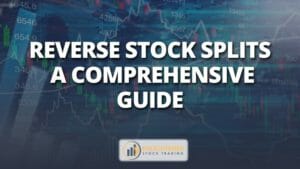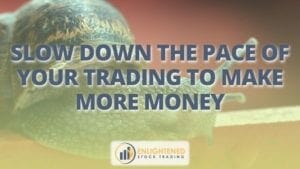Click Here to Read the Video Transcript
Okay. So what I wanted to talk about is short selling because short selling is something that a lot of people come into the market without understanding, and also have a lot of fear of. And so in this little section, what I wanted to do is explain what short selling is again, just to make sure that everyone is clear, then draw out what some of the concerns are, what some of the real issues or things you should be aware of. And then talk, maybe if we’ve got time, about the slippery dip system and how that works, and why that works. So that’s the plan for the next little while.
So what is short selling? Just by show of hands, give me a thumbs up if you’re completely comfortable, you understand what it is and you can teach it to the group, or a thumbs down if you have no clue, and sideways if you sort of understand.
Okay, great. We’ve got some sideways action. That was a wave, Linda. Is that a thumbs up, sideways, or down?
Sorry, sideways.
Oh, cool. Okay, great. All right. So let’s illustrate with an example. Who owns a nice car? Anyone own a car? Okay. Pauline, let’s put a value on your car. I’m not going to ask you what the car is. Let’s call it a Ferrari. Okay. So Pauline, do you own a Ferrari?
Oh, yes.
For the purpose of this exercise, yes. Okay. And for the purpose of this exercise, your Ferrari is worth $250,000. Okay. Fair enough?
Yep.
Great. Okay. Pauline, can I borrow your Ferrari for the next month? I guarantee that I will give it back in exactly the same condition, not a scratch, not an extra mile. I just want to borrow it. Is that good?
Yep, fine.
Right. Now, will you charge me a small percentage of the value of that Ferrari as a fee for borrowing it?
Oh, yes.
Yes. Okay. And would that be, I don’t know, 5% or 10% per year, approximately, that fee?
Sounds good.
Good. Ferraris are pretty easy to borrow. So the fee to borrow a Ferrari, not that high. Let’s say I went to Kylie, and Kylie owned a one-of-a-kind McLaren, custom built, worth 5,000,000 bucks or something. I don’t know, making shit up for the purposes of an example.
Very hard to borrow, right? The McLaren compared to the Ferrari. So Kylie, you might charge me a slightly higher or a lot higher percentage of the value to borrow your McLaren, right? But I’m not borrowing McLaren today. I’m borrowing a Ferrari from Pauline. Okay. So Kylie, bad luck. Sorry, you don’t get my business.
Okay. So I’m borrowing Pauline’s Ferrari and I’m going to pay Pauline 5% per year, the value of that in exchange for the borrow of the Ferrari. Good. Okay. Now, I think the value of Ferraris are going down because there’s coronavirus and people aren’t buying fancy cars, and Ferrari is just going to crap as a company, and all of that stuff.
So value of Ferrari is going down, let’s face it. So I found Simone, who is a ready buyer of a Ferrari. And Simone wants to buy a Ferrari for $250,000 today, right? I happen to have a Ferrari, it’s worth $250,000. I’ve borrowed it, but I’ve got it right here. Okay. So Simone, I’m going to sell you the Ferrari for $250,000. You got it? You’re going to buy it from me? Great.
So I sell you the Ferrari and you give me $250,000. Good? Good. Okay. Pauline still wants her Ferrari back, but not yet. So now the market from Ferraris collapses. See, my trading system told me Ferrari prices were going down, and Pauline says to me, “Hey, I want my car back.” And Linda happens to have a Ferrari, which is the same.
So Linda, the market price for Ferraris right now is only $150,000. So you don’t want your Ferrari anymore, you’re trying to sell it because you’ve seen the value of it collapse, and you don’t want to lose any more money, right? So Linda, I’m going to buy your Ferrari from you for $150,000. Okay. Happy with that?
Great. So I give Linda $150,000 and I get a Ferrari. So now Pauline says, “Hey, Adrian, I want my Ferrari back.” I say, “Cool. Pauline, here’s your Ferrari. By the way, stop charging me that 5% per year, because I’ve given it back to you now. We’re done, we’re square.”
So now, Pauline has her Ferrari back. Simone has a Ferrari, I have $250,000 minus the $150,000 I gave to Linda. So who made money from the whole deal? Well, I did. That’s what a short sale is. It’s a short sale because I sold something that I don’t own. I had to go borrow it, sold it, and then bought it back at a lower price, and gave it back to the owner. That’s what short selling is.
Now, with stocks, I don’t have to go hunting around for someone who owns XYZ stock to borrow it from them, to sell it, to then buy it back at a lower price to make money. The broker does it all for you. So that whole borrowing thing is transparent. It happens behind the scenes and it’s instantaneous in most cases.
So if you want to short sell Apple stock, all you do is you open up your interactive brokers. You type in the Apple ticker, you press sell. You type in how many shares you want to short sell and what price, and order type and so on, and you press transmit, and you are then short the Apple stock. You automatically then get charged the stock borrow fee, which is typically pretty small.
And when you want to close the position, instead of selling it, you have to buy it, because what happens is, let’s say you sold a 1,000 shares in Apple. You sold them short, means you didn’t have them in the beginning. Before you did the transaction, the number of shares you owned in Apple was zero.
Then you borrowed a 1,000 of them and you sold them. So now the number of shares in Apple you own is -1,000. So to get -1,000 shares in Apple back to zero, you have to buy 1,000 shares. So a short sale starts with a sell order, ends with a buy order. A long sale, which is what you’re used to, starts with a buy order and ends with a sell order.
Okay. So that’s what short selling is. I’m going to pause for questions. Does that all make sense? Was that completely clear or confusing? Okay. Simone, makes sense?
Yeah.
Dave, makes sense? Dave is just wishing he had a Ferrari.
Yeah. I’m just wondering why I’m the only one who doesn’t have a Ferrari?
Okay. Linda and Kylie, you’re good? Okay. All right. So what are the risks of short selling? Okay. Here’s a risk. Let’s go back to the Ferrari example. I borrowed Pauline’s Ferrari and I sold it to Simone. I’m now short one Ferrari. Let’s say the Ferrari factory burned down.
Now, if the Ferrari factory burnt down, they won’t get to produce any cars for the next five years when they rebuilt it. Again, extreme example, what would happen to the price of Ferraris? , right?
Now, if a business, a company that you were short, like you were short ABC stock, and the company’s factory burnt down, the company’s share price is not going to skyrocket. Okay. It’s going to collapse. Good for a short seller. Okay, but don’t be an arsonist, just you’re going to profit from bad news. Okay.
But in the Ferrari example, restriction of supply cause price to go up. So let’s say instead of $250,000, when Pauline says to me, “Hey, Adrian, I want my Ferrari back.” I go looking in the market and I go to Dave, and Dave’s got a Ferrari, but no one else has got Ferraris. And Dave has gone like, “I’ll give me my Ferrari. It’s going to cost you $750,000.
I’m like, “Shit. Well, I’ve got a contract with Pauline. I have to give her, her Ferrari back. I’ve got no choice. And if I don’t do it manually, like by myself, the broker will force the transaction.” So Dave, I have to give you $750,000 to buy a Ferrari. And then I’ve going to give the Ferrari back to Pauline.
Now, Pauline doesn’t make any money out of that because Pauline has just got the same Ferrari she had before. But how much money did I make? Almost 500 grand because I short sold at $250,000, but I had to buy it back at $750,000. That’s the problem or the challenge, the risk with short selling. If the asset that you borrowed sell, suddenly sky rockets, that is your loss.
Now, let me ask you this. If you buy ABC stock at $10 per share, what’s the worst possible outcome for that trade? It goes to zero. Okay. Now, if I borrow ABC stock and short sell it at $10 a share, expecting it’s going to go down, but in fact, it actually goes the other way and goes up. What’s the worst possible outcome for that trade? Infinity, theoretically. Right.
Now, stocks don’t usually go to infinity overnight because infinity is a lot of money. And if your stock went to infinity, then you’re screwed because you are now infinitely broke, and the broker will come chasing you for that infinite debt. But stocks can go up a lot overnight. So if you short sell ABC stock at $10 a share, expecting it’s going to fall, but something crazy happens overnight and it jumps a 100%, so my loss is actually just the $10. It’s the 100% lift in price, that’s my loss.
But if it jumped 500% overnight, not common but possible, then it’s a much bigger loss. So what does that mean about short-selling? What are the implications for your risk management? So you want each trade in each stock to be small because stock can jump a long way, but the overall market isn’t going to jump a huge amount overnight.
The market could rally heavily and go up 5%, 10%, 15% maybe. I haven’t even checked the stats, what the biggest overnight jump in the market is, but it could… let’s say it could go up 5% or 10% overnight. That’s not going to break you if you were short the whole market. But if you’re short one stock and it went up 500% or a 1,000%, which I guess could theoretically happen, then you’re really going to hurt.
So each trade has to be very small. You can have a lot of short trades, but you don’t want any of them to be big because they’ll hurt you if they go wrong. What are the other implications for short-selling? Either in-market or you want to make sure you’re monitoring closely, right?
And you’re going to need to backtest in-market stop-losses versus next bar and open stop-losses. The risk with next bar and open stop-losses is that, let’s say you’re short of stock today. It rallies overnight. It doesn’t quite hit your stop-loss, but it’s gone against you. And then the next day, during the day, it passes through your stop and that triggers the stop. And you’re going to exit the next bar and open, but overnight before the next bar, it rallies again. So you can end up with two overnight gaps that hurt you.
So an in-market stop loss is a bit more attractive in that respect, but that can also impact profitability. So you’re going to have to backtest both in-market and next bar and open to check and make sure you understand the impact of those. How much of your capital would you put on the short side compared to the long side? Which is riskier, long or short? Short, absolutely. No question.
So how much capital… Would you put more capital on the long side or more capital on the short side? Yeah, more on the long side, generally. It depends on a couple of things. If you’re shorting individual stocks, the risk is higher than if you were shorting an ETF, or the whole market through like an index fund or something like that, which is essentially an ETF because you’d be shorting the spy or something like that.
So I’d be more comfortable having more capital when I’m shorting an ETF, or like an ETF shorting system than a stock shorting system, because I don’t want to get hurt by a sudden rally and stocks. But one of the things you want to do when you’re thinking about your risk management on the short side is consider the extreme scenario, because the challenge is the extreme scenario in the long side is the market really collapses.
But it can’t go through past zero, right? We’re buying stocks which are a part of a company. The company can only go to zero, that’s kind of built into the definition of a corporate structure. The shareholders can’t end up owing money. We’re protected from that. So the shareholder can’t end up in a negative position unless they use leverage.
So assuming you’re cash only, no leverage, the worst case on the long side is zero, but because it’s not true on the short side and companies can really rally fast and hard, and you’ve got, for some systems, the risk of two overnight gaps, which could be really big. Then you want probably less exposure and smaller positions.
Some people, there’s a lot of literature around that talks about when bear markets happen, that’s when you really make the most money. And while it’s true that when you’re short-selling, you generally make money quickly, it’s also very volatile.
And so, I personally use it to smooth returns in the portfolio because the longs are losing money. I use the shorts to kind of buffer that and reduce the size of the drawdown, rather than trying to really cash in and make a fortune. You could, but you’ve got to be quite aggressive. And with that, comes a level of risk that I’m just not comfortable with.
So I guess that aspect is a bit up to you. If you were wanting to be really aggressive when the market collapsed, you probably could make a lot of money very quickly, but it comes with bankruptcy risk or blowing up your account risk. And my philosophy for trading is I never ever want to blow up an account ever.
I haven’t, since when I started and I don’t intend to, because I don’t trade with capital allocations, position size and leverage, that would really cause that to happen.









Share This
Share this post with your friends!